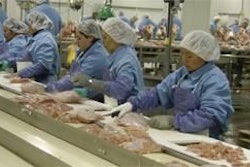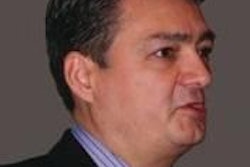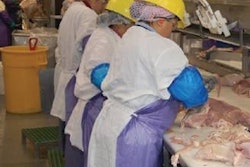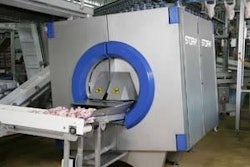
Utilizing a large anaerobic lagoon gives Sanderson great treatment results at a relatively low cost.
Sanderson Farms believes in standardization. All of the company's wastewater treatment plants, including the one at Moultrie, have essentially the same components. The Moultrie, Ga., broiler processing plant uses around 1.5 million gallons of water per day to process 250,000 head of six pound broilers. The only difference in the wastewater treatment at Moultrie from Sanderson's older plants is the land application system for discharge of the treated wastewater, which was required by the state.
At Moultrie, screened wastewater goes straight into a covered 15.4 million gallon anaerobic lagoon, Sanderson does not use dissolved air flotation (DAF) systems. The choice to not use a DAF means Sanderson's treatment systems require more land, but it lowers the overall treatment cost. The large footprint is possible because Sanderson has chosen sites for its plants with plenty of room. Some of the low cost results from the combination of the anaerobic lagoon followed by a Schreiber activated sludge treatment system. Return of waste sludge to the anaerobic lagoon provides a system where land application and rendering of sludge have been eliminated. The waste sludge is digested into methane by bacteria in the anaerobic lagoon. Not using a DAF also reduces chemical cost and eliminates the cost of hauling DAF skimmings for either rendering or land application.
Bob "Pic" Billingsley, director of development and engineering, Sanderson Farms Inc., said the company sets its own wastewater treatment performance standards based on the capabilities of the treatment system. These standards are always set much lower than the permit limits. Billingsley said that the design of Sanderson's wastewater treatment allows the company to minimize cost over the long haul when compared to operating a DAF and the system gives Sanderson relatively low treatment cost when compared to the industry's average cost.
The membrane cover on the anaerobic lagoon, which cost around $1 million, allows for the collection of around 350 million cubic feet of methane per day. Sanderson is evaluating options for cleaning and burning this gas to fuel boilers or to run a generator to produce electricity and hot water.
Standardization of wastewater treatment at Sanderson makes it easier to train personnel, move them from one facility to another and the operation easier to manage. Brenda Flick, environmental services manager, and Dwayne Holifield, wastewater treatment manager, both work out of Sanderson's corporate office in Laurel, Mississippi, and provide support to the on-site wastewater treatment personnel. Each plant sends in its test results to the corporate office every day. At 9:30 each morning, Holifield and the site supervisors, including Moultrie's supervisor Chad Meadows, have a conference call to go over that day's results. This allows for brainstorming among on-site supervisors regarding results and lets each site benefit from the group's collective years of experience with the treatment system.
With this setup, Sanderson is able to operate individual locations with less staff. The Moultrie plant has a wastewater treatment supervisor and one operator. The processing plant's maintenance department provides 24/7 backup and performs checks of the automated systems but round the clock staffing of the wastewater treatment plant site is not required. Sanderson also has two workers who operate, monitor and maintain the equipment at the over-400-acre spray fields. Performance of the treatment system has been outstanding and the effluent has very low nutrient levels after treatment. The Moultrie plant was named the winner in the full treatment category.
We've all heard the term black gold being used to refer to crude oil. Poultry wastewater and biosolids (sludge) aren't really black like crude oil but they do have a wealth of energy. It just takes some ingenuity to figure out how to capture this energy in a form that can be put to use. Tyson's Noel, Mo., a broiler processing plant, has found a way to capture oil and methane during its wastewater treatment process and has reduced the volume of the biosolids that need to be land applied as it has generated revenue from these by-products.
Capturing feed grade fat
A tricanter system is employed at Noel to remove chicken fat from the DAF skimmings. This fat is recycled at the company's feed mill back into broiler rations. In 2008, they removed 900,000 pounds of fat using the tricanter with a value of $280,000.
Prior to entering the tricanter, the DAF skimmings are heated up to 180 to 220F. The heated material enters a three-phase centrifuge. Around 7% of the total volume entering the tricanter is removed as fat. The other two fractions exiting the tricanter are water and solids. The solids portion is 40% water, 11 to 15% fat and 37% protein.
Tyson, H2O Tech and Stoney Point AgriCorp. Inc. are working with Texas A&M University to test the solids portion as cattle feed. The goal is to convert all of the nutrients in the DAF skimmings into valuable by-products and eliminate the need to haul these offsite for land application. As recently as 2003-2004, 56 million pounds of DAF skimmings were produced and hauled off-site.
The anaerobic lagoon at the Noel plant is covered and the methane produced is currently being flared off. Plans have been developed to clean the gas and burn it in one of the processing plants' boilers.
Noel's wastewater treatment plant exists to support a 260,000 head per day broiler processing plant. The 6.1 pound average live weight birds are processed almost exclusively for Wal-Mart and Sam's Club stores into net weight tray pack items and whole birds. Water usage has been cut from 10.2 gallons per bird in 2002 down to 4.89 gallons per bird today as a result of water conservation and water reuse. Tyson Foods Noel, Missouri, was named runner-up in the full treatment category.
Sometimes even our best and most productive assets get a little too old and can't keep up and have to retire. This holds just as true for wastewater treatment plants as it does for aging athletes. Just as 38 years is a little long in the tooth to play center field, 38 years is also pretty old for a pretreatment plant.
Tyson Foods Inc. operates a broiler processing plant in Monett, Mo., that slaughters around 270,000 head of 3.9 pound birds per day. The plant also produces over 1 million pounds of marinated parts daily.
For nearly four decades, the wastewater pretreatment plant kept up with production and treated 1.2 million gallons of wastewater per day. But, over time, the treatment capabilities of the system were stretched and it became clear more treatment capacity would be needed if production was going to be expanded or changed.
In the fall of last year, Tyson opened its new $4.8 million pretreatment plant at Monett. The new facility gives the processing plant the flexibility to expand production and increase loading of the wastewater if they need to. With the new facility, DAF skimmings production has been cut from 72,000 gallons to 30,000 gallons per week. These biosolids are land applied, so this reduction offers significant savings. Chemical costs have also been reduced with the new system.
Becky Thomas, complex environmental manager, and her staff have always done a great job treating the Monett plants wastewater. The plant was one of the first winners of USPOULTRY's Clean Water Award for pretreatment several year ago using the old treatment system. Thomas insists on keeping everything spotless, and the new treatment facility looks as clean as it would have on Day One. Everything is cleaned, including the two DAF tanks which are cleaned at the end of each week.
Tyson Foods Inc. Monett, Mo., plant was named the winner in the pretreatment category.
Wayne Farms LLC has a further processing complex in Decatur, Ala., consisting of two further procesing plants and one cold storage facility. Combined, the two plants produce around 3 million pounds of further processed products on nine production lines in a six-day work week.
In 2008, the wastewater treatment processes of the two plants were conslidated and the flows combined andare now treated using a high efficiency DAF system prior to discharge to the city's treatment plant. Operation of the DAF is controlled by an automated feedback system which was designed and integrated by the Decatur plants' maintenance staff, who have responsibility for wastewater treatment.
Jesse Fletcher, utilities superintendent, said that they first developed an automated jar testing system to address varying waste loads from prodcution operations. Chemical feed rates are PLC controlled and are based on both effluent and influent water quality, as traditional jar test procedures are replaced with automated turbidity methods. A self-cleaning turbidity tester, which provides feedback for the chemical addition, is used. The PLC determines the optimum polymer and coagulant settings and this allows the plant to achieve a higher quality effluent while reducing labor costs and chemical consumption.
A PLC is also used to control the polymer blending process to ensure the correct amount of water and the consitent blend time are used every time. With the new automation systems, the wastewater plant has been able to treat its effluent to a level where any surcharges from the city are largely a thing of the past.
Wayne Farms' Decatur further processing plants were named the runner-up in the pretreatment category.

















